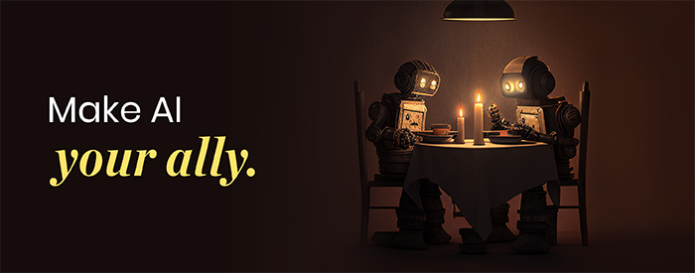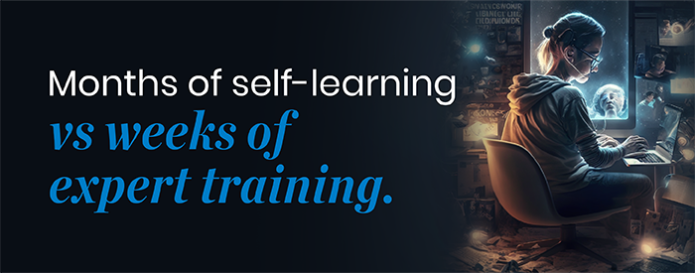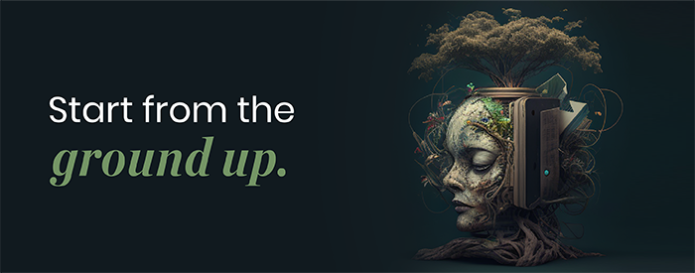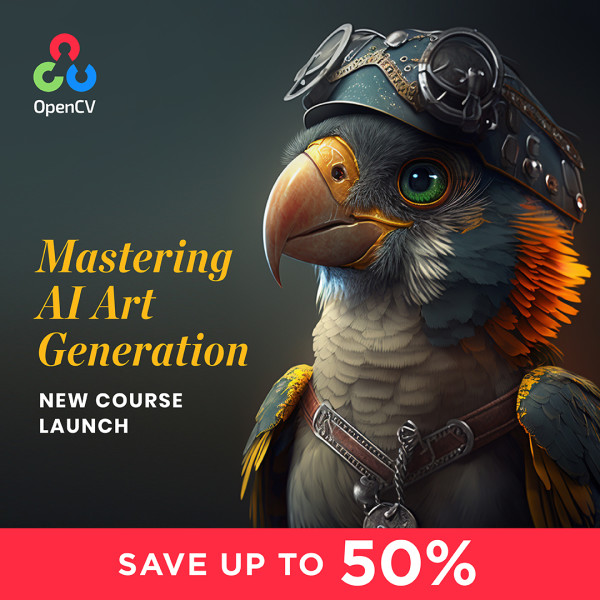
Create AI-generated art like a Pro. Gain the first-mover advantage with OpenCV’s new courses.
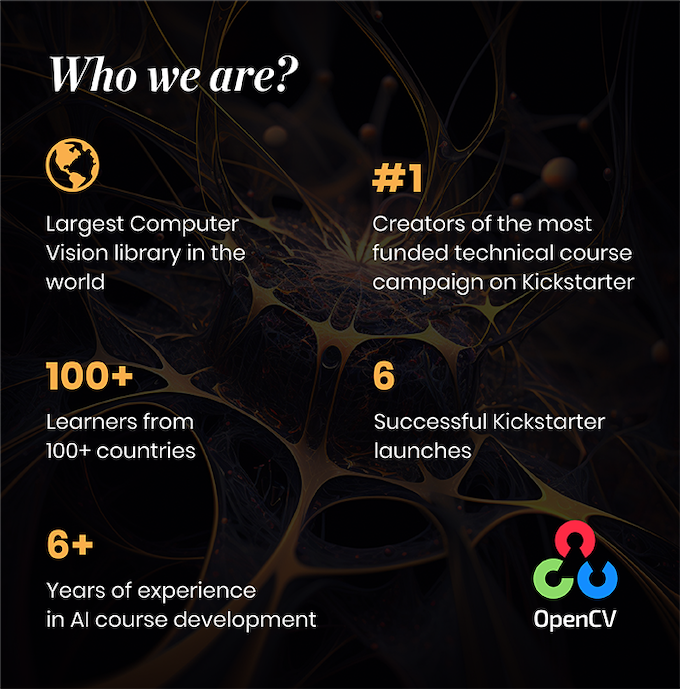
We, at OpenCV.org, are on a mission to educate a global AI workforce. We have been offering comprehensive online courses in Computer Vision to professionals, job-seekers and enthusiasts from over 100 countries.
Professionals and students from top global institutions choose our courses to upskill.
To stay relevant in today’s evolving creative environment one needs to adapt, learn and upskill. And OpenCV’s courses help you exactly do that. Whether you are a designer, engineer, architect or an artist; if you love to imagine, you have landed at the right place.
Break out of the years of conditioning, explore new possibilities. Make the AI your ally. Dissect and decode Stable Diffusion. Learn from the experts and practitioners, take a shortcut into one of the fastest growing technology i.e. Generative AI.
Here’s your chance to gain the first-mover advantage in the new realm of creativity.

You will learn all the tricks and techniques of generating images, fine tuning them, and turning algorithms into impactful AI art, step-by-step. And, if you are interested in pushing your limits, by creating a new app or model, why not? We have covered it all.

- Fundamentals of producing AI art: Get a strong understanding of the basics of AI-generated art, and learn how to use the tools and techniques to create your own unique pieces
- Prompt engineering: Discover the art and science of crafting prompts that bring out the best in your models and generate stunning creatives
- Model fine-tuning: Learn how to insert your own characters, styles, and objects into your models, and fine-tune them to get the exact results you want
- Image editing: Know the controlled editing techniques by using available tools to refine and get a perfect output. Like creating a virtual try-on app or a virtual interior designer or a virtual make-up artist
- Animating your images: Learn the fundamentals of animating your images, and take your art to the next level.
- Building your own models: Using Stable Diffusion create your own applications. For example, generating characters for a new movie, creating avatars for yourself or your clients, etc.
You need no experience, start from scratch. If you are new to the creative realm, give yourself a boost. If you are a seasoned creative, sharpen your skills and gain the mastery in AI generated art, apps and models.
- Got zero programming knowledge? Go for AI Art generation for everyone
- Have basic programming knowledge? Advanced AI art generation is for you
- Want to gain complete mastery? Grab the bundle
All you need is tons of interest and curiosity in AI Art Generation – yes, that’s it!
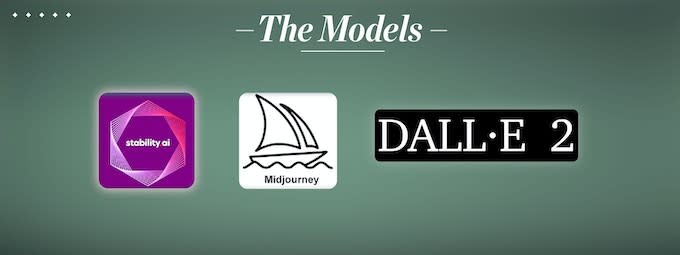
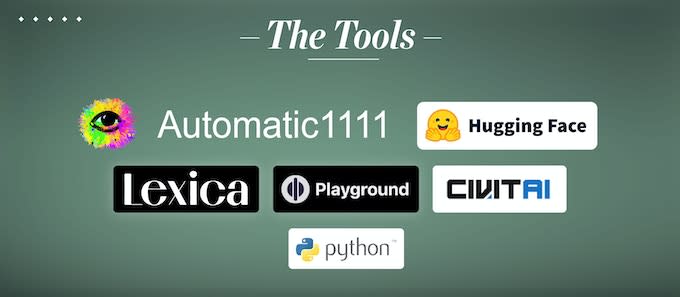
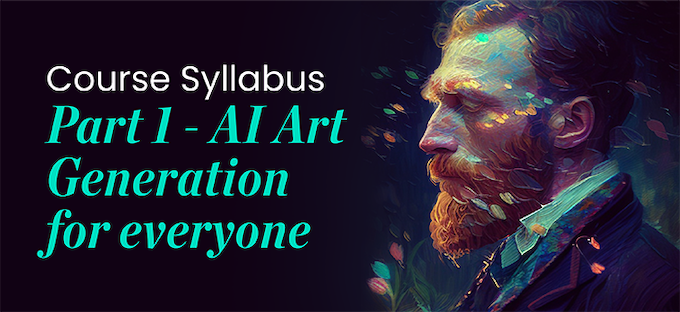

Understand the generative AI landscape along with the state-of-the-art models and where to find new ones. Also, learn about the various supporting tools for generating stunning images.
Understand the Technology and the Tools

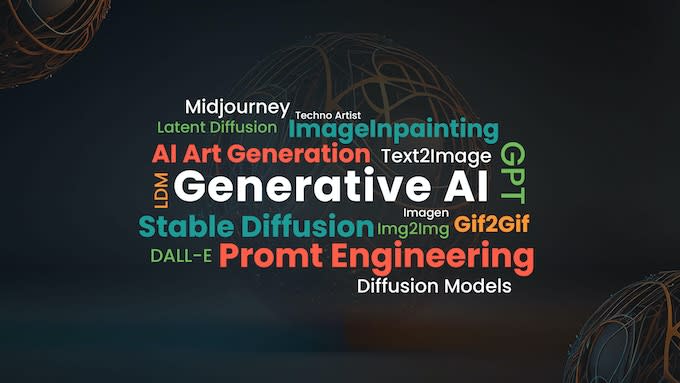

Get started with the model that started the AI Art Generation revolution. OpenAI’s DALL-E 2 is simple, yet powerful enough to produce amazing results only with a few words.

Learn to use the most expressive and artistic AI Art Generation model. You can generate stunning results in no time by leveraging the power of MidJourney.

Here, you will learn to use StabilityAI’s Dreamstudio platform and generate AI art using Stable Diffusion, the model that became the buzzword due to its open-source nature and accessibility.

Want to generate unlimited AI Art but not a fan of limited credits? We have got you covered. Generate as many images as you want with the Stable Diffusion WebUI tool, be it your local system, Google Colab or a cloud deployment.


The Generative AI Art model is as good as its prompt. Learn how to extract the best results from Stable Diffusion by writing expertly-driven prompts with Prompt Engineering.

Stable Diffusion is not all about generating images from prompts. You can generate variations of an image, add, and remove objects from an image as well, all with Controlled Editing.
Object Removal using InPainting

Inserting Objects using Masks

Paint on an Infinite canvas using OutPainting


Want to know what a statue might look like in a Robot avatar? Or how good a jacket will look on you without exactly leaving your house? Or maybe you want to try a particular shade of makeup. With InstructPix2Pix, you can now control how to add elements and edit images with very simple prompts.
Virtual Try-on
Instead of browsing on your favorite shopping website, Just create an app that enables you to try out everything on the catalog. 😀

Change dress, ties and accessories!

Virtual Hairstyle
Try out different hairstyles before committing to it.

Virtual Make-up
Create applications to change make-ups virtually!

Look into the Future
Create an Oldify App!

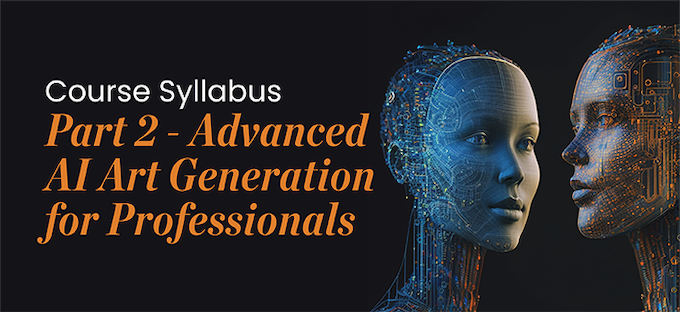
Are you a programmer and want to dive deeper into Stable Diffusion? Here, you will learn how to fine-tune Stable Diffusion on your own images using two of the most popular methods, DreamBooth and Textual Inversion. After this, you will have the skill to generate your own AI Avatars in any style you want. Additionally, you will also learn how to train a GPT language model for Advanced Prompt Engineering to speed up the process of AI Art Generation, from ideation to execution

Coming up with good prompts can be time-consuming and may not always give the best results. Learn how to train the GPT language model and leverage its language modeling power for Advanced Prompt Engineering.

Creating personalized AI-generated Avatars is the new craze powered by generative models. You can do that too by training Stable Diffusion on your own images using the DreamBooth technique.

AI Art Generation models are powerful and have huge contextual knowledge, but not all. You will face situations where you may want to generate some new images that the Stable Diffusion model may not know about. Using the Textual Inversion technique, you can teach Stable Diffusion to generate a new style or character with just 10-15 images.


Want to generate stylized videos from a sequence of images or want to repurpose an image into an Animation? Using the Stable Diffusion WebUI you can easily learn to process a batch of images and create unique videos in almost any style and texture you want.
 Have you ever wondered how to leverage the power of image editing tools like Photoshop in an easy and accessible manner? Using advanced Stable Diffusion models like Paint By Example, you can edit images intelligently like a Pro!
Have you ever wondered how to leverage the power of image editing tools like Photoshop in an easy and accessible manner? Using advanced Stable Diffusion models like Paint By Example, you can edit images intelligently like a Pro!
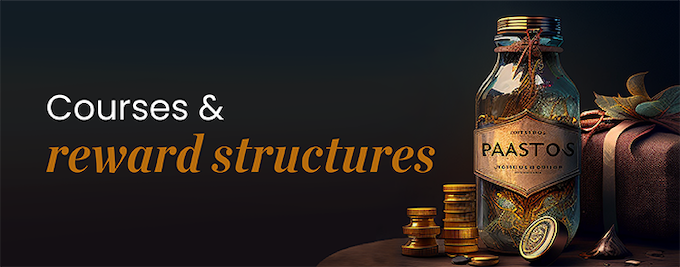
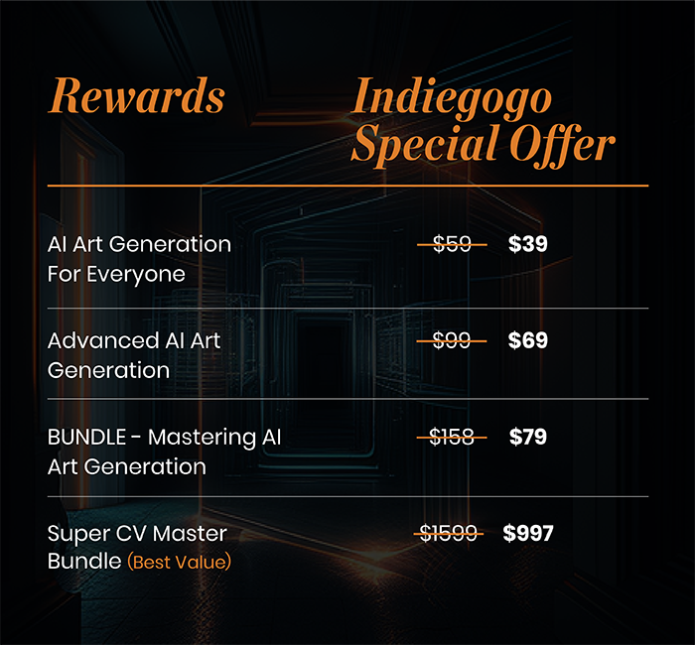
Free ‘Python For Beginners’ Course: All our backers who have pledged for a reward and/or add-on will get the ‘Python For Beginners’ course, absolutely FREE!
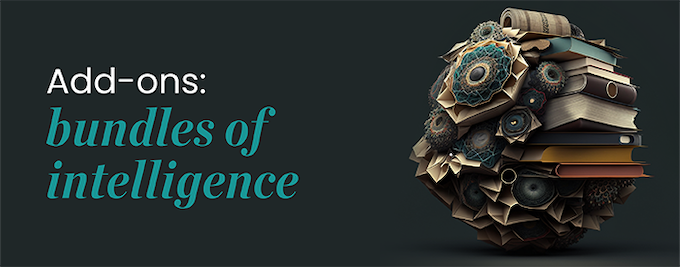
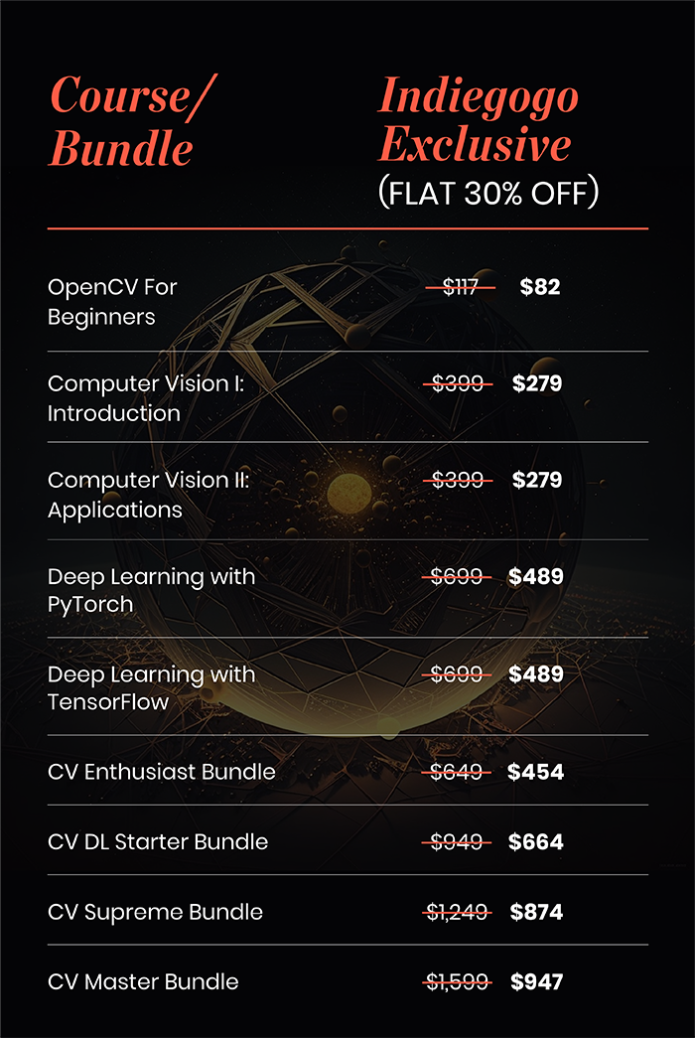
Learn more about our existing course offerings here: https://opencv.org/courses/
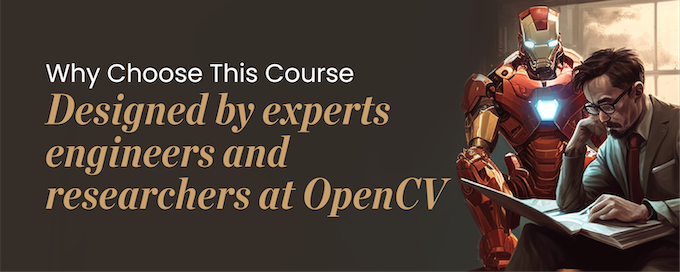
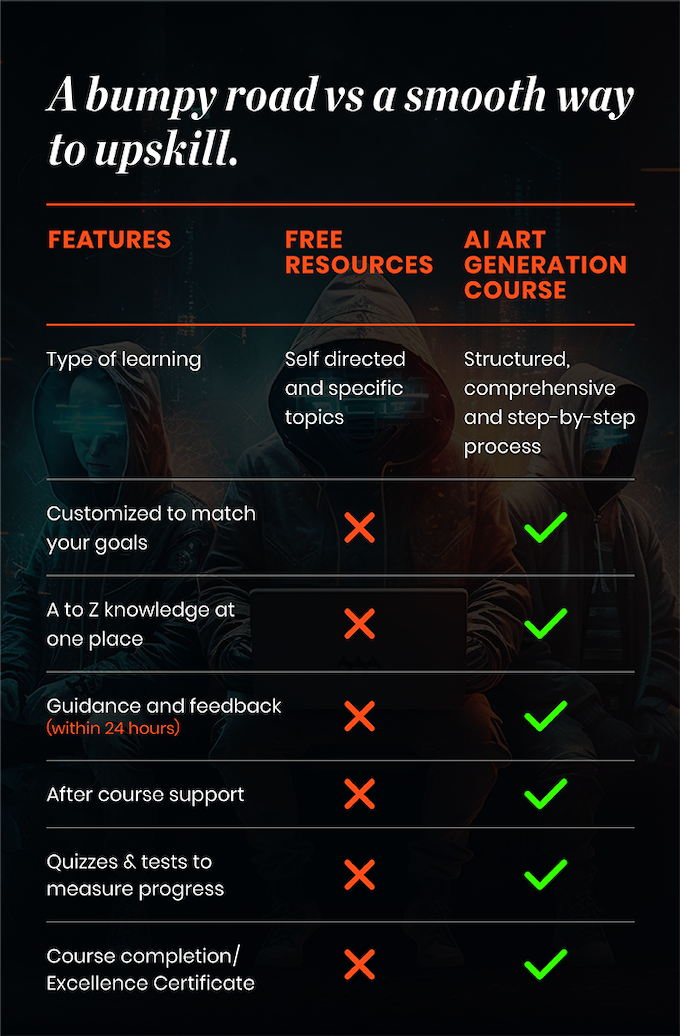
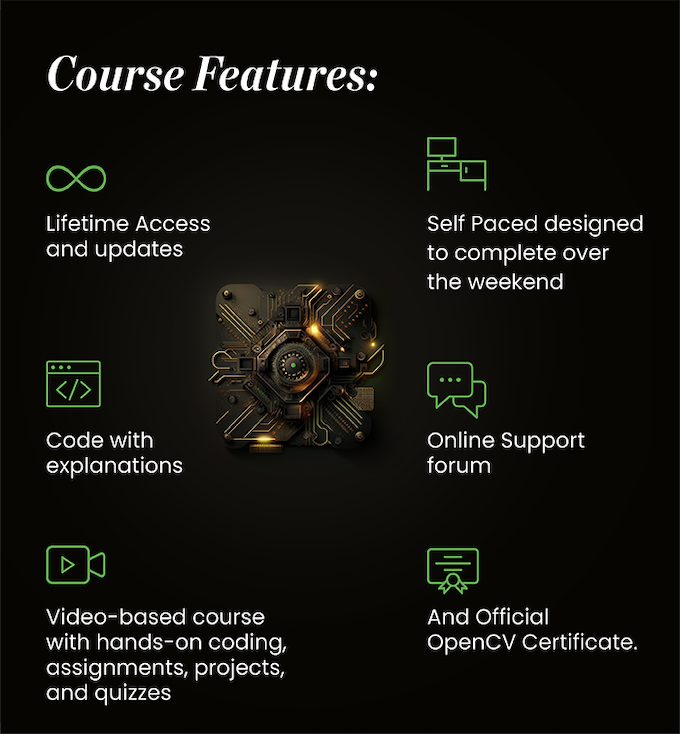

We take great pride in each and everyone who completes our courses successfully. Upon completion of this course, we will award you with a digital certificate from OpenCV.org. You can showcase it across your social profiles, and give a kickstart to your career and continued studies in the field of Computer Vision.
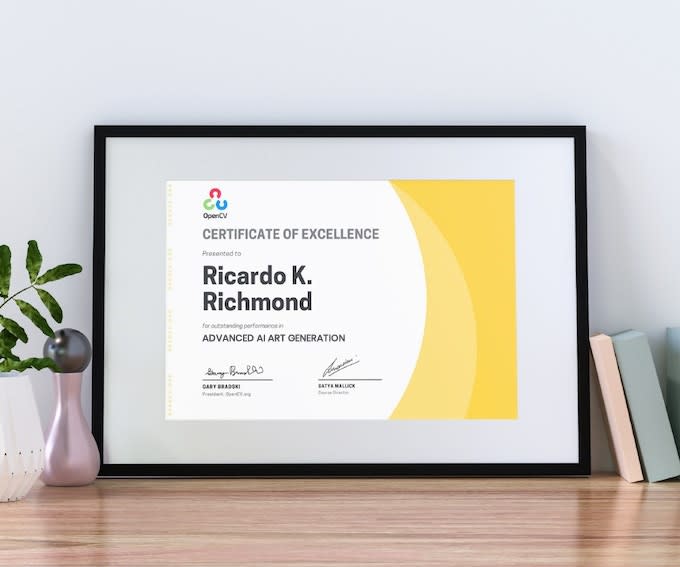
Project Timeline
Nov 2022 – Research work started
Feb 2023 – 25% course completed
Feb 2023 – Crowdfunding Campaigns launched
Mar 2023 – 50% course targeted
April 2023 – Crowdfunding Campaign ends
May 2023 – 100% completion and public launch
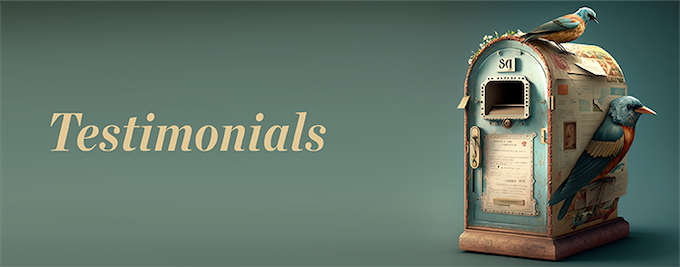

One of the things which has surprised me that I like the most – I noticed it because I have worked through a number of online courses in the past – is the length and style of the videos. They break up the content for each lesson segment into a very easy-to-consume block of time, which has actually made it much easier to maintain progress in the course. Since I have a day job, this is a huge win for me. The staff are incredibly responsive and helpful without just handing out answers – I like this especially as it means I’m still figuring it out in the end even if I do need to ask for assistance. All of this has really helped me to actually learn the content, and I feel like the investment has been well worth it.

These exceptionally well-organized courses provide immense value to AI professionals. You can keep using the content as a reference long after completing the courses. I recommend AI programs by OpenCV to everyone interested in working in this field.

The course exceeded my expectations in many regards — especially in the depth of information supplied. The keyword “engineering oriented” surprised me nicely. Next amazing thing was the mathematics – everything is described very detailed and in depth. Which is unusual with nowadays courses. The course is very well organized and conceived. By following it, I was able to learn and build on the concepts with minimal questions or frustration.

I am really impressed with the mix of rich content offered in the course (video + text + code), the reliable infrastructure provided (cloud based execution of programs), assignment grading and fast response to questions on forums. I should specifically mention the clarity of explanations provided in the video lectures and very good real world examples provided. For the course load part, I feel it is light enough to understand and challenging enough to stretch and learn to appreciate our own effort! Overall, I feel this has been one of the top
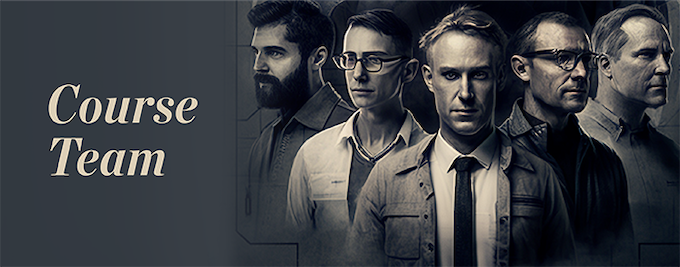

- One of the top 30 AI influencers to follow on Twitter as per IBM Watson blog (2017)
- Alumnus of Indian Institute of Technology (IIT), Kharagpur and Ph.D. from the University of California (San Diego)
- Author of Computer Vision blog LearnOpenCV.com
- Work featured in publications such as BBC, Time, Huffington Post, Wall Street Journal, Oprah Magazine, TechCrunch and TheRegister.co.uk

- BS from University of California, Berkeley and Ph.D. from Boston University in AI, Machine Learning and Neuro-Modeling
- Served as a Visiting Professor at Computer Science Department, Stanford University for 7 years
- Founder of the most powerful and popular Computer Vision library in the world, OpenCV.org
- Organized the Computer Vision team for Stanley, the autonomous car that won the $2M DARPA Grand Challenge and currently displayed at the Smithsonian Air and Space Museum

- AI & Computer Vision Researcher and an Alumnus of Indian Institute of Science (IISc), Bangalore
- Leading planning and development of our Computer Vision and AI courses, in partnership with OpenCV
- Over a decade of rich experience as Professor, AI Engineer and Data Scientist
- Worked on various Deep Learning and Computer Vision projects with Samsung and Snapdeal
- Interested in doing research in the field of Machine Perception, Scene Understanding, Deep Learning and Robotics

- Prior to joining Big Vision, Pranav was a Co-founder at Lensbricks. Lensbricks built several technologies that helped identify key moments in a video. Pranav’s team developed a camera called Kiba which could find joyful moments in any camera recording
- Pranav has been a researcher at Nokia Research and MIT Media Labs in the past. At Nokia Research, he won several awards for being the top innovator in Asia
- Pranav has earned 15 granted US Patents in the field of Computer Vision
- He completed his graduation from the Indian Institute of Technology (IIT), Bombay in Signal Processing and Communications

- Masters degree in Aeronautics and Astronautics from Massachusetts Institute of Technology (MIT), including graduate course work in Machine Learning and Image Processing at Stanford University
- Extensive experience in the space science and defense industries, supporting several major development programs and research efforts for over two decades
- Background in modelling and simulations, satellite systems, orbital analysis and machine learning
Risks and challenges
Our risk assessment to roll out the product is LOW with HIGH DEGREE of DELIVERY CONFIDENCE in May 2023. We have completed the course design and are in the advanced stages of development. We have a strong track record of successfully delivering AI, Computer Vision and Deep Learning courses. AI professionals and enthusiasts from more than 100 countries have benefited from our courses.
Our course instructors are truly world-class with exceptional credentials in AI and Computer Vision research, education and consulting.


